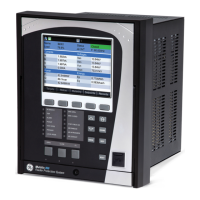1–34 850 FEEDER PROTECTION SYSTEM – INSTRUCTION MANUAL
SPECIFICATIONS CHAPTER 1: INTRODUCTION
FREQUENCY
Nominal frequency setting:...........................50 Hz, 60 Hz
Sampling frequency:.........................................64 samples per power cycle
128 samples per power cycle (available for transient
recorder
Tracking frequency range:.............................3 to 72 Hz
ARC FLASH SENSOR/FIBER
Number of Point Sensors:...............................4
Detection Radius: ...............................................180 degree
Maximum Fiber Length (Point Sensor):..... 18 ft
Fiber Size: ...............................................................1000 um
Mode:........................................................................Multi-mode
Connector: .............................................................Small Media Interface (SMI)
Fiber Type: .............................................................Plastic Optical Fiber
Bend Radius:.........................................................>25 mm
CONTACT INPUTS
Number of Inputs: ..............................................Based on relay order code
Type:.........................................................................Wet or Dry (Wet for I/O Card C)
Wet Contacts:....................................................... 300 V DC maximum
Selectable thresholds: ......................................Programmable:
17 VDC (For 24 VDC Operating Voltage)
33 VDC (For 48 VDC and 60VDC Operating Voltage)
84 VDC (For 110 VDC and 125 VDC Operating Voltage)
166 VDC (For 220 VDC and 250 VDC Operating Voltage)
Tolerance:...............................................................17VDC: Vlow(off)<10V, Vhigh(on)>19V
33VDC: Vlow(off)<23V, Vhigh(on)>38V
84VDC: Vlow(off)<70V, Vhigh(on)>88V
166VDC: Vlow(off)<140V, Vhigh(on)>176V
Recognition time:................................................1 ms (typical)
Debounce time: ...................................................0.0 to 16.0 ms in steps of 0.5 ms
Continuous current draw (burden):............2 mA (1 mA for I/O Card C)
CLOCK
Setup: ....................................................................... Date and Time, Daylight Saving Time, UTC (Coordinated
Universal Time)
Backup Retention: ..............................................1 hour
IRIG-B INPUT
Auto-detect:..........................................................DC and AM
Amplitude Modulation:.....................................1 V to 10 V pk-to-pk
DC Shift:...................................................................TTL
Input Impedance: ............................................... 40 kΩ
Isolation: .................................................................2 kV
RTD INPUTS
Types (3-wire):...................................................... 100 Ω Platinum, 120 Ω Nickel, 100 Ω Nickel, 10 Ω Copper
(RMIO only supports 100 Ω Platinum)
Sensing current: .................................................. 5 mA
Range:......................................................................–40 to +250°C (-40 to +482°F)
Accuracy: ...............................................................±2°C (±4°F)
Isolation: .................................................................36 V pk-pk (a group of RTDs to ground)
2 kV from base unit (RMIO only)
Lead Resistance: .................................................25 Ohms max. per lead for platinum or nickel and 3 Ohms
max. per lead for copper RTDs
RTD Inputs Available: ........................................6 RTD inputs with one module or 12 inputs with 2 modules
(IO cards R or S).
1 RTD input with IO card L.
6 to 12 RTD inputs with RMIO modules 1 through 4

